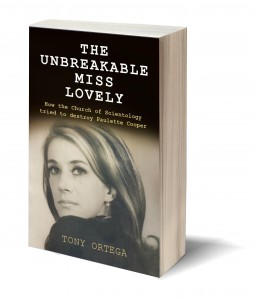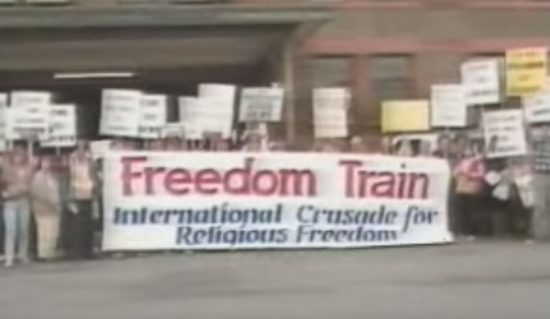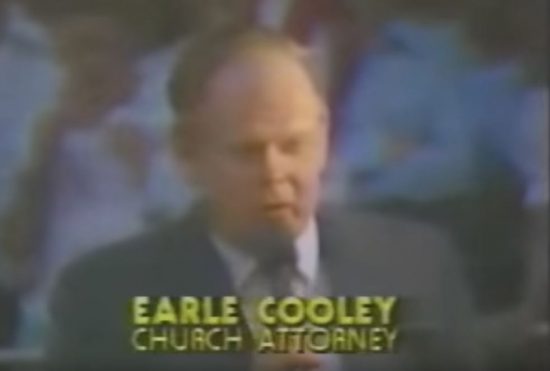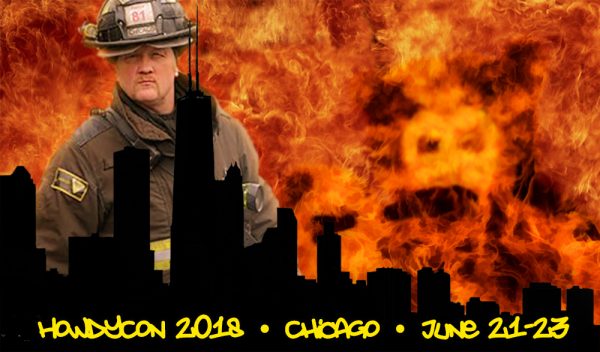Yesterday, we pointed out that a Scientology demonstration in Budapest reminded us of the famous “Battle of Portland” that took place in 1985. It just so happens that historian Chris Owen has been working on a detailed look at the Portland adventure, which we’re posting in two parts. Here’s the first half, which explains how a lawsuit in Oregon turned into one of Scientologys’ most famous public demonstrations.
Portland, Oregon holds a special place in Scientology’s collective consciousness. In 1985 thousands of Scientologists descended on the city to participate in what the Church dubbed the “Battle of Portland.” A Scientology promotional email from 2013 calls the episode Scientology’s “Gettysburg, the turning point, the pivotal event of the first half century of our religion.” It was a moment at which Scientology’s survival was at stake, but which it overcame through a combination of intelligence tactics, dirty tricks, public relations and creative lawyering in equal measure.
The cause of this threat was a lawsuit brought by a young woman, Julie Christofferson Titchbourne, who had attended the Portland organisation of the Church of Scientology. A former resident of the small town of Eureka, Montana, she had graduated from high school with excellent grades and aimed to go to college in Portland to study architecture and engineering there.
A friend suggested that she try a $50 Scientology “communications course” in Portland. Lured by claims that Scientology would improve her eyesight and make her more intelligent, Titchbourne spent all of her college savings on further Scientology courses. She soon became dissatisfied but was advised to enroll at the Scientologist-run Delphian Foundation in Sheridan, Oregon. She testified that she was told it was “almost accredited” and she could study engineering there. However, she instead found herself picking vegetables, looking after children, and moving garbage.
Titchbourne left Scientology after nine months following an intervention from her mother, who hired a “deprogrammer” to help break her out of the Scientology mindset. She sued for the refund of around $3,000 that she had paid for Scientology courses, compensation of $500,000 for emotional suffering, and $2 million in punitive damages for fraud.
When the case went to trial in 1979, a 40-person unit from the Church’s Guardian’s Office (GO) reportedly organized a “witness college” at Portland’s Heathman Hotel. Martin Samuels, the head of the Church of Scientology Mission of Davis, later said that Scientology witnesses were coached to lie, admitted that he had committed perjury, and said that other Scientologists had given perjured testimony at the trial. The church lost the case and Titchbourne was awarded $2 million.
Despite claims that L. Ron Hubbard was no longer involved in Scientology’s management, he was in fact directing the Church’s strategy in the Christofferson case. In August or September 1979 he instructed the GO to undertake a five-pronged strategy to deal with the Titchbourne case. The steps he ordered were to file a counterclaim against Titchbourne; bring criminal charges against the litigants; launch criminal proceedings against the “instigators and perpetrators” of the case (meaning the deprogrammers and Titchbourne’s mother); disprove false testimony; and take legal action against the judge who had heard the case “for his making a mockery of the trial, including criminal proceedings as his actions are assuredly based in actual crimes.”
The GO responded in November 1979 by secretly issuing Guardian Program Order (GPgmO) 4115-2, titled “Julie’s Background,” in which it set out “broad steps to be taken to document that the people involved in the Christo case are criminals with criminal backgrounds and criminal records and that they engaged in a criminal conspiracy to defraud the organization under the guise of ‘home and mother’.” The program’s stated objective was to document the “criminal background, drug history, record of arrests, former employment, perversions of Julie.”
Agents of the GO’s intelligence staff, Bureau 1, were to be sent to Montana to track down anyone who had known Christofferson and “find her boyfriends to get all data about her early promiscuity and sexual conduct.” “Discreditable data” was to be obtained from friends, neighbors, and colleagues with an emphasis on finding out “everything they know about Julie with emphasis on discreditables and/or criminal activities and/or perversions.” Her mother was also targeted, as were the deprogrammers with whom she had been involved: “The intention is to see these people in prison or out on bail at the time of the [Church’s] appeal.” The program order concluded:
“All this evidence is to be assembled with an eye to establishing that Julie Hall [Titchbourne] was probably a drug addict, probably has a large and extensive criminal background and record and has been party to other collusions and swindles or crimes or felonies possibly from her earliest history.”
It seems that these plans were initially either put into effect only partially or not at all. While the Guardian’s Office was in favor of settling, Hubbard was strongly opposed, as was David Miscavige, who had increasingly come to play a leadership role while Hubbard remained in hiding on a ranch in California. They feared that settling could encourage others to make similar claims against Scientology. When Hubbard learned that Mary Sue was seeking to settle, he sent fresh orders denouncing “GO defeatism” and reiterating his earlier instructions on handling the case. The Church’s earlier lawyers were replaced with attorneys who were willing to take a much harder line.
In August 1981 a new Program Order was issued, titled “Christo Final Handling Eval,” setting out a series of actions for handling the case. It provides clear evidence that Hubbard was directing the strategy, as it repeatedly refers to “R advices” and “Senior Advices” – code terms for orders from L. Ron Hubbard.
The Program Order called for the instigation of an “Offensive Suit … with a big PR flank.” Intelligence material on the trial judge was to be “used to the hilt as we want criminal proceedings against this judge as well and prior to the Appeal being filed.” Criminal proceedings were also to be brought against the “instigators and perpetrators” of the case and the appeal was to be “filed and pushed to the win.” Progress on these goals was to be reported to the All Clear Unit, a body set up by David Miscavige in 1981 to handle all litigation against Hubbard.
The attempts to prosecute those involved in the case fell flat. The Church made its “big PR flank” with claims that the Titchbourne case was part of a criminal conspiracy involving the foreman of the trial jury, the judge and Titchbourne’s attorney, but got little traction. Papers seeking criminal prosecutions were filed with the local US Attorney and a countersuit was filed but was dismissed by the courts.
The Church’s defensive litigation was more successful. The Oregon Court of Appeals overturned the ruling on First Amendment grounds and ordered a new trial in 1982, directing that only claims of a secular nature could be considered [Associated Press, May 3, 1982]. After more legal argumentation, the case came before a jury in the Multnomah County Circuit Court in Portland.
The court heard much damaging testimony about Scientology and L. Ron Hubbard over the course of ten weeks from March to May 1985. Hubbard had been added to the lawsuit earlier in the proceedings but he was reportedly incommunicado at the time and seems to have played no part in managing the Church’s defense.
This task fell instead to David Miscavige, who based himself in rented rooms in a condo near the courthouse. Mark “Marty” Rathbun, then a member of the All Clear Unit, later recalled: “Miscavige and I directed a couple dozen staff, frenetically working through each and every night to provide Earle [Cooley, Scientology’s lead attorney] with material to discredit each witness on cross examination … We liberally used material from the ethics records from their days in the church, even copying internal records on the cross [examination].”
Gerry Armstrong, Hubbard’s former archivist turned witness for the prosecution, came in for particularly harsh treatment as the Church sought to use undercover surveillance tapes to discredit him. Scientology’s veteran private investigator, ex-LAPD cop Gene Ingram, and a young Scientologist named Mike Rinder had set up a covert operation that recorded Armstrong making seemingly compromising statements. The tactic backfired, with the judge angrily rebuking the Church for its tactics [Rathbun, Memoirs of a Scientology Warrior, p.. 268-9]. Nonetheless, the Scientology team was so confident of victory that it took the unusual step of not calling any witnesses for its own defense.
The verdict came as a profound shock to the Scientologists. After half a day of deliberations, the jury unanimously convicted the Church of Scientology of fraud. It awarded Titchbourne $39 million, comprising $1.5 million from the Church of Scientology Mission in Davis, Portland; $17.5 million from the Church of Scientology of California, which was the “mother church” of Scientology at the time; and $20 million from Hubbard, who was living in hiding in Creston, California at the time. A default judgement was entered against him as he had failed to respond to the suit.
The judgment was a disaster for Scientology. Cooley managed to secure a slender lifeline by persuading Judge Donald Londer to delay recording the verdict for a few days, ensuring that further representations could be made before the verdict was finalized.
On the evening of May 17, Miscavige and other senior Scientology executives and lawyers held an emergency strategy meeting.
— Chris Owen
Tomorrow, in Part 2: Miscavige’s desperate plan to intimidate the court.
——————–
Jeffrey Augustine talks to Katrina Reyes
You read Katrina’s story on Monday. Now listen to her conversation with Jeffrey.
——————–
L. Ron Hubbard at Target Two: 32 years and counting
Thank you, RMycroft, for reminding us that today is the 32nd anniversary of the Commodore — er, Admiral — dropping his meat body and leaving to pursue his OT research elsewhere.
Two years ago, we marked the big 30th anniversary of L. Ron Hubbard’s death with a fun new find — an obituary written by one of the people who knew the pre-Scientology Hubbard best, his former literary agent and friend, Science Fiction superfan Forrest Ackerman.
It’s an illuminating tribute to a man Ackerman considered “as neither saint nor devil but an extraordinarily complex unique individual whom I would rank in the ‘odd genre.'”
Sail on, L. Ron!
——————–
Make your plans now!
——————–
Bernie Headley has not seen his daughter Stephanie in 5,004 days.
Brian Sheen has not seen his grandson Leo in 150 days.
Clarissa Adams has not seen her parents Walter and Irmin Huber in 1,213 days.
Carol Nyburg has not seen her daughter Nancy in 1,987 days.
Jamie Sorrentini Lugli has not seen her father Irving in 2,761 days.
Quailynn McDaniel has not seen her brother Sean in 2,107 days.
Claudio and Renata Lugli have not seen their son Flavio in 2,601 days.
Sara Goldberg has not seen her daughter Ashley in 1,641 days.
Lori Hodgson has not seen her son Jeremy and daughter Jessica in 1,353 days.
Marie Bilheimer has not seen her mother June in 879 days.
Joe Reaiche has not seen his daughter Alanna Masterson in 4,968 days
Derek Bloch has not seen his father Darren in 2,108 days.
Cindy Plahuta has not seen her daughter Kara in 2,428 days.
Claire Headley has not seen her mother Gen in 2,403 days.
Ramana Dienes-Browning has not seen her mother Jancis in 759 days.
Mike Rinder has not seen his son Benjamin and daughter Taryn in 5,061 days.
Brian Sheen has not seen his daughter Spring in 1,167 days.
Skip Young has not seen his daughters Megan and Alexis in 1,570 days.
Mary Kahn has not seen her son Sammy in 1,442 days.
Lois Reisdorf has not seen her son Craig in 1,024 days.
Phil and Willie Jones have not seen their son Mike and daughter Emily in 1,529 days.
Mary Jane Sterne has not seen her daughter Samantha in 1,773 days.
Kate Bornstein has not seen her daughter Jessica in 12,882 days.
——————–
 Posted by Tony Ortega on January 24, 2018 at 07:00
Posted by Tony Ortega on January 24, 2018 at 07:00
E-mail tips and story ideas to tonyo94 AT gmail DOT com or follow us on Twitter. We post behind-the-scenes updates at our Facebook author page. After every new story we send out an alert to our e-mail list and our FB page.
Our book, The Unbreakable Miss Lovely: How the Church of Scientology tried to destroy Paulette Cooper, is on sale at Amazon in paperback, Kindle, and audiobook versions. We’ve posted photographs of Paulette and scenes from her life at a separate location. Reader Sookie put together a complete index. More information can also be found at the book’s dedicated page.
The Best of the Underground Bunker, 1995-2017 Just starting out here? We’ve picked out the most important stories we’ve covered here at the Undergound Bunker (2012-2017), The Village Voice (2008-2012), New Times Los Angeles (1999-2002) and the Phoenix New Times (1995-1999)
Learn about Scientology with our numerous series with experts…
BLOGGING DIANETICS: We read Scientology’s founding text cover to cover with the help of L.A. attorney and former church member Vance Woodward
UP THE BRIDGE: Claire Headley and Bruce Hines train us as Scientologists
GETTING OUR ETHICS IN: Jefferson Hawkins explains Scientology’s system of justice
SCIENTOLOGY MYTHBUSTING: Historian Jon Atack discusses key Scientology concepts
Other links: Shelly Miscavige, ten years gone | The Lisa McPherson story told in real time | The Cathriona White stories | The Leah Remini ‘Knowledge Reports’ | Hear audio of a Scientology excommunication | Scientology’s little day care of horrors | Whatever happened to Steve Fishman? | Felony charges for Scientology’s drug rehab scam | Why Scientology digs bomb-proof vaults in the desert | PZ Myers reads L. Ron Hubbard’s “A History of Man” | Scientology’s Master Spies | The mystery of the richest Scientologist and his wayward sons | Scientology’s shocking mistreatment of the mentally ill | The Underground Bunker’s Official Theme Song | The Underground Bunker FAQ









